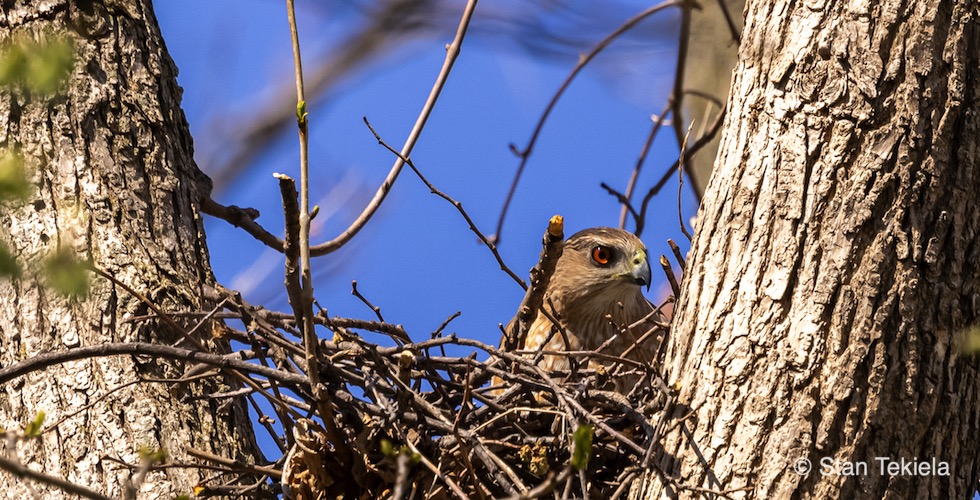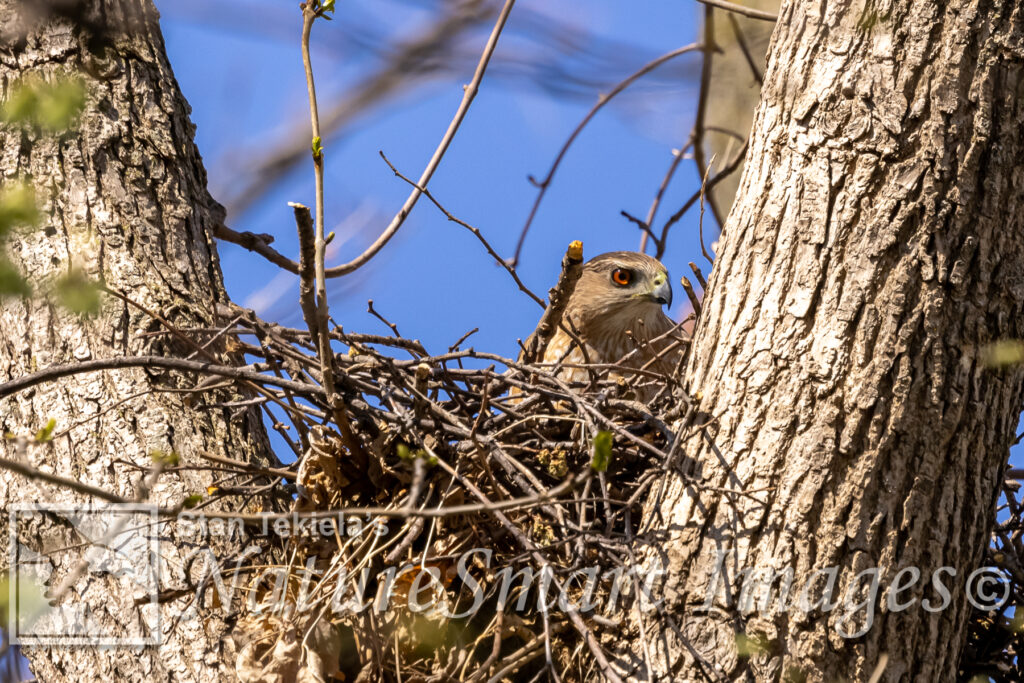
A Cooper’s Hawk’s Life is Not Easy
Each spring in nature there is a lot of tragedy and triumph, heartbreak and happiness, success and failure. As the natural world gets down to the task of replenishment, not all critters will be lucky enough to raise their young. This was painfully obvious to Stan Tekiela when he was filming and documenting a Cooper’s Hawk (Accipiter cooperii) family. Here is his account.
The Cooper’s Hawk is an amazing top predator. As its name implies, it’s a type of hawk. A medium-size woodland hawk with short broad wings and a long narrow tail, it is often seen swooping around and chasing birds at backyard bird-feeding stations.
These hawks are some of the most widespread and common of all the raptors. They are found in every state in the country except for Alaska. During winter they will migrate out of many of the northern states for several months, but they quickly return in the spring.
They are often referred to as “true hawks” and are famous for their amazingly quick and agile flight. And they need this rocket-like flight to capture their prey. These hawks make a living at eating other birds. They prey on anything from warblers and sparrows to larger birds such as mourning doves, but one of their favorite foods is the Northern Flicker, which is a large woodpecker species. Either way, other birds are always on the menu.

They can be stone-cold killers and are considered to be on the top of the food chain, but that doesn’t always protect them. This spring, I had been observing a female Cooper’s Hawk that was building a nest about 40 feet up in a small tree. For many days she brought in stick after stick, slowly building up a nest platform large enough for her to sit comfortably and also accommodate her eggs and eventual offspring.
I spent a lot of time scouting out the area, trying to figure out the best angle to film the nest and the forthcoming young. I finally decided upon the angle. Next, I brought in my small one-person blind and set it up in a suitable area. The blind was located about 50 yards away from the nest to ensure I wasn’t impacting the hawk. I climbed into the blind to make sure the view was good.
This is the most important part of the photo setup. Placement of the blind can make or break a shot. Making sure I am not impacting the bird while it goes about its daily routine is extremely important to capturing natural behaviors. So, the blind needs to cover me and all my camera gear with the exception of the front of the lens. Then all I have to do is wait a couple of days for the mother to become accustomed to the blind and for the eggs to hatch.
So, as you can see there is a lot of prep work needed for just one photo shoot. And I was very excited to get started. I was planning on spending many, many hours covered up, in cramped quarters, out in the woods. But one night something happened. The predator became the prey.
I don’t know what harmed the bird because I wasn’t there at night, but something happened, and the bird who sat at the top of the food chain was knocked off the top spot. When I arrived one morning, the mother was gone. I am guessing that a predator came in and went after the incubating female and the eggs. It could have been any number of other predators both avian or terrestrial, and I don’t want to point fingers and play the blame game, but this predation points out the simple fact that Mother Nature doesn’t follow the rules that we put forth for her. Mother Nature is hard and oftentimes difficult.
We need to remember that only the strong survive and that predation is what propels Mother Nature forward into the future in a much stronger and vibrant fashion. And it doesn’t matter if we people think it’s cruel or unusual. Because it is how nature works, and we need to learn to understand and accept it.
If you enjoyed Stan’s post about Cooper’s Hawks, you may enjoy one of his amazing nature books: Wild Birds, Backyard Birds: Welcomed Guests at our Gardens and Feeders, and his latest book Bald Eagles: The Ultimate Raptors.
You can follow Stan on Facebook and Twitter, or contact him via his web page. Stan’s nationally syndicated NatureSmart Column appears in more than 25 cities spanning 5 states (Minnesota, Wisconsin, Michigan, Illinois, and Pennsylvania) and is circulated to more than 750,000 readers.
For more stories about wildlife and nature, sign up for our newsletter now!


